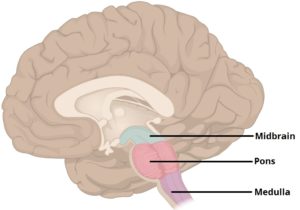Apr 30 2018
Keeping Brains Alive Outside the Body
 Researchers at Yale report (at a meeting – not yet published) that they were able to keep pig brains alive for up to 36 hours after the pigs were decapitated. They acquired the pig head from a slaughterhouse, and experimented on them about 4 hours after death. This research is a long way from an alive “brain in a jar” but it does raise some early ethical questions.
Researchers at Yale report (at a meeting – not yet published) that they were able to keep pig brains alive for up to 36 hours after the pigs were decapitated. They acquired the pig head from a slaughterhouse, and experimented on them about 4 hours after death. This research is a long way from an alive “brain in a jar” but it does raise some early ethical questions.
First the technical stuff, with the caveat that the study is not yet published in the peer-reviewed literature so some details are sparse. We know the researchers experimented on pig heads. The report does not say explicitly whether the brains were completely removed from the skulls or not, but they did have access to the brain itself so it was at least exposed if not removed. They attached a series of pumps to the blood vessels and pumped oxygenated blood through them. They also used drugs to prevent the brains from swelling, and the researchers say these drugs would also prevent some brain cell activity (they are channel blockers).
They used brain-surface EEG to record electrical brain activity and – there was none. The pig brains were flat-line. But when they later dissected the brain tissue there was cellular activity for up to 36 hours.
This is clearly a baby step in the direction of maintaining a living brain outside of a body. Four hours after death is a long time, and there would certainly already be a lot of cellular death by that point. If the goal (and this wasn’t their goal) is to maintain a fully functional extracorporeal brain, then it would need to be hooked up to external blood flow within minutes of death, not hours. You can’t just get pig heads from the slaughterhouse.
But there is no theoretical reason why this would not work. If the brains were kept oxygenated throughout the process, and they were hooked up to an external system that fed oxygenated blood with managed CO2 levels and a supply of glucose (basically normal arterial blood), there is no reason why the cells could not survive for a long time. There are likely to be many technical hurdles here, but as a thought experiment it seems plausible.


 We are in an interesting phase of developing 3D printing technology – the ability to print real objects in three dimensions. The technology clearly works and has applications. The question is – will 3D printing remain a niche technology, or will it revolutionize manufacturing, how consumers obtain certain items, and even introduce new possibilities in medicine and wearable tech?
We are in an interesting phase of developing 3D printing technology – the ability to print real objects in three dimensions. The technology clearly works and has applications. The question is – will 3D printing remain a niche technology, or will it revolutionize manufacturing, how consumers obtain certain items, and even introduce new possibilities in medicine and wearable tech? In 1968, 50 years ago, Paul Ehrlich and his wife published The Population Bomb, which famously predicted mass starvation by the end of the next decade. Ehrlich’s predictions failed largely because of the green revolution, the dramatic increase in agricultural productivity. You would think that being famous for a dramatically failed prediction would bring humility, but Ehrlich is still at it.
In 1968, 50 years ago, Paul Ehrlich and his wife published The Population Bomb, which famously predicted mass starvation by the end of the next decade. Ehrlich’s predictions failed largely because of the green revolution, the dramatic increase in agricultural productivity. You would think that being famous for a dramatically failed prediction would bring humility, but Ehrlich is still at it.  The art of magical illusion is partly exploiting people’s expectations. Our brains encode a model of how we expect the world to work. When we let go of something, it should fall to the ground. If it doesn’t, we are surprised. This also means that our behavior is predictable – we will tend to look for the object to fall to the ground, meaning the magician will know where we are going to look and can take advantage of that to do things out of our sight.
The art of magical illusion is partly exploiting people’s expectations. Our brains encode a model of how we expect the world to work. When we let go of something, it should fall to the ground. If it doesn’t, we are surprised. This also means that our behavior is predictable – we will tend to look for the object to fall to the ground, meaning the magician will know where we are going to look and can take advantage of that to do things out of our sight. A recent
A recent  It has rapidly become conventional wisdom that the widespread use of social media has resulting in an increase in the “echochamber effect.” This results from people only consuming media that already is in line with their existing beliefs and ideology. This is nothing new, psychologists have long documented that people are much more likely to access information that reinforces their existing beliefs and biases, and much less likely to engage with information that directly challenges their beliefs.
It has rapidly become conventional wisdom that the widespread use of social media has resulting in an increase in the “echochamber effect.” This results from people only consuming media that already is in line with their existing beliefs and ideology. This is nothing new, psychologists have long documented that people are much more likely to access information that reinforces their existing beliefs and biases, and much less likely to engage with information that directly challenges their beliefs. It’s clear from the fossil record that at times in the history of Earth there have been massive and geologically rapid changes in the assemblage of life. For each such change, however, there is the question of what caused the change. Perhaps the most famous is the K-Pg extinction (Cretacious-Paleogene extinction) about 66 million years ago, known for the near extinction (except for birds) of perhaps the most iconic prehistoric clades, the dinosaurs.
It’s clear from the fossil record that at times in the history of Earth there have been massive and geologically rapid changes in the assemblage of life. For each such change, however, there is the question of what caused the change. Perhaps the most famous is the K-Pg extinction (Cretacious-Paleogene extinction) about 66 million years ago, known for the near extinction (except for birds) of perhaps the most iconic prehistoric clades, the dinosaurs. Three weeks ago
Three weeks ago 




